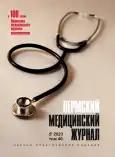Эпидемиологическая характеристика гепатита с в Нижегородском регионе на первом этапе программы по борьбе с инфекцией (2016–2021 гг.)
- Авторы: Кашникова А.Д.1, Полянина А.В.1, Зайцева Н.Н.1, Быстрова Т.Н.1
-
Учреждения:
- Нижегородский научно-исследовательский институт эпидемиологии и микробиологии им. академика И.Н. Блохиной Роспотребнадзора
- Выпуск: Том 40, № 5 (2023)
- Страницы: 100-109
- Раздел: Профилактическая и социальная медицина
- URL: https://journals.rcsi.science/PMJ/article/view/254811
- DOI: https://doi.org/10.17816/pmj405100-109
- ID: 254811
Цитировать
Полный текст
Аннотация
Цель. Охарактеризовать особенности проявления эпидемического процесса вирусного гепатита С (ГС) в Нижегородском регионе на первом этапе программы по борьбе с инфекцией (2016–2021 гг.).
Материалы и методы. Ретроспективный анализ заболеваемости регистрируемыми формами ГС-инфекции на территории Н. Новгорода выполнен с использованием информационных сборников статистических и аналитических материалов Роспотребнадзора. Из банка сывороток крови отобрано 78 883 образца от лиц, проходивших обследование на догоспитальном этапе и при поступлении в стационары неинфекционного профиля с 2016 по 2021 г. Лабораторное исследование включало определение маркёров инфицирования вирусом гепатита С: анти-ВГС классов иммуноглобулинов M и G, антител к структурному и неструктурным белкам (n = 2953). Серопозитивные образцы исследованы на наличие геномной РНК ВГС (n = 467) методом ОТ-ПЦР в режиме Real-Time.
Результаты. В 2016–2021 гг. в Н. Новгороде установлена тенденция к снижению заболеваемости регистрируемыми формами гепатита С. Установлено, что среди ряда предполагаемых путей передачи и факторов риска заражения гепатитом С превалирующими являются употребление инъекционных наркотических средств в анамнезе и половой путь передачи. По результатам проведённого сероэпидемиологического исследования инцидентность анти-ВГС составила 3,6 ± 0,1 % Распространённость РНК ВГС среди взрослого населения – 1,8 ± 0,1 %, максимальных значений показатель распространенности маркёра текущей инфекции достигал в возрастных группах 30–39 лет (3,3 ± 0,3 %) и 40–49 лет (5,7 ± 0,5 %). Для достижения целей программы по борьбе с гепатитом С необходимо проведение целенаправленных динамических сероэпидемиологических исследований, позволяющих увеличить количество обследованных лиц на наличие маркёров ГС-инфекции с последующим расширением доступности и охвата эффективной противовирусной терапией лиц с активной инфекцией.
Полный текст
Открыть статью на сайте журналаОб авторах
А. Д. Кашникова
Нижегородский научно-исследовательский институт эпидемиологии и микробиологии им. академика И.Н. Блохиной Роспотребнадзора
Автор, ответственный за переписку.
Email: gabckad@gmail.com
ORCID iD: 0000-0001-9893-5848
SPIN-код: 6002-8194
научный сотрудник лаборатории эпидемиологии вирусных гепатитов
Россия, Нижний НовгородА. В. Полянина
Нижегородский научно-исследовательский институт эпидемиологии и микробиологии им. академика И.Н. Блохиной Роспотребнадзора
Email: polyanina.anastasia@yandex.ru
ORCID iD: 0000-0003-1258-5467
SPIN-код: 8245-4909
Scopus Author ID: 57194604102
кандидат медицинских наук, ведущий научный сотрудник – заведующий лабораторией эпидемиологии вирусных гепатитов
Россия, Нижний НовгородН. Н. Зайцева
Нижегородский научно-исследовательский институт эпидемиологии и микробиологии им. академика И.Н. Блохиной Роспотребнадзора
Email: micro@nniiem.ru
ORCID iD: 0000-0001-5370-4026
Scopus Author ID: 7101903242
доктор медицинских наук, директор
Россия, Нижний НовгородТ. Н. Быстрова
Нижегородский научно-исследовательский институт эпидемиологии и микробиологии им. академика И.Н. Блохиной Роспотребнадзора
Email: gepatit-bystrova@yandex.ru
ORCID iD: 0000-0002-2719-6328
Scopus Author ID: 57225802197
доктор медицинских наук, профессор, ведущий научный сотрудник лаборатории эпидемиологии вирусных гепатитов
Россия, Нижний НовгородСписок литературы
- WHO. Гепатит С, available at: https://www.who.int/ru/news-room/fact-sheets/detail/hepatitis-c.
- Pol S., Lagaye S. The remarkable history of the hepatitis C virus. Genes and Immunity 2019; 20: 436–446.
- Gower E., Estes C., Blach S. et al. Global epidemiology and genotype distribution of the hepatitis C virus infection. Journal of Hepatology 2014; 61: 45–57.
- WHO Regional Office for Europe. Action plan for the health sector response to viral hepatitis in the WHO European Region. 2017; 5: 1–45.
- Hatzakis A., Chulanov V., Gadano A.C. et al. The present and future disease burden of hepatitis C virus (HCV) infections with today’s treatment paradigm – Volume 2. Journal of Viral Hepatitis 2015; 22: 26–45.
- Han R., Zhou J., François C. et al. Prevalence of hepatitis C infection among the general population and high-risk groups in the EU/EEA: A systematic review update. BMC Infectious Diseases 2019; 19: 1–14.
- Maaroufi A., Vince A., Himatt S.M. et al. Historical epidemiology of hepatitis C virus in select countries – volume 4. Journal of Viral Hepatitis 2017; 24: 8–24.
- Hofstraat S.H.I., Falla A.M., Duffell E.F. et al. Current prevalence of chronic hepatitis B and C virus infection in the general population, blood donors and pregnant women in the EU/EEA: A systematic review. Epidemiology and Infection 2017; 145: 2873–2885.
- Geneva: World Health Organization. Global health sector strategies on, respectively, HIV, viral hepatitis and sexually transmitted infections for the period 2022–2030. World Health Organization. Switzerland 2022; 134.
- Blach S., Terrault N.A., Tacke F. et al. Global change in hepatitis C virus prevalence and cascade of care between 2015 and 2020: a modelling study. The Lancet Gastroenterology & Hepatology 2022; 7: 396–415.
- Blach S., Zeuzem S., Manns M. et al. Global prevalence and genotype distribution of hepatitis C virus infection in 2015: A modelling study. The Lancet Gastroenterology and Hepatology 2017; 2: 161–176.
- Перечень поручений по реализации Послания Президента Российской Федерации Федеральному Собранию Российской Федерации от 21 апреля 2021 года, available at: http://www.kremlin.ru/acts/assignments/orders/65524.
- Михайлов М.И., Ющук Н.Д., Малинникова Е.Ю., Кюрегян К.К., Исаева О.В., Знойко О.О., Климова Е.А. Вирусные гепатиты – проблема общественного здоровья в Российской Федерации (проект программы по контролю и ликвидации вирусных гепатитов). Оргздрав: Новости, Мнения, Обучение. Вестник ВШОУЗ 2018; 2: 20–29.
- План мероприятий по борьбе с гепатитом С, available at: http://government.ru/news/46972
- Соболева H.В., Карлсен А.А., Кожанова Т.В. и др. Частота выявления антител к вирусу гепатита С среди условно здорового населения Российской Федерации. Журнал микробиологии 2017; 3: 99–106.
- Соболева Н.В. Распространенность вируса гепатита С среди условно здорового населения Российской Федерации: автореф. дис. … канд. биол. наук. М. 2020; 25.
- Ющук Н.Д., Знойко О.О., Якушечкина Н.А. и др. Оценка социально-экономического бремени гепатита С в Российской Федерации. Эпидемиология и вакцинопрофилактика 2013; 2: 18–33.
- О состоянии санитарно-эпидемиологического благополучия населения в Российской Федерации в 2022 г.: Государственный доклад. М.: Федеральная служба по надзору в сфере защиты прав потребителей и благополучия человека 2023; 368.
Дополнительные файлы









